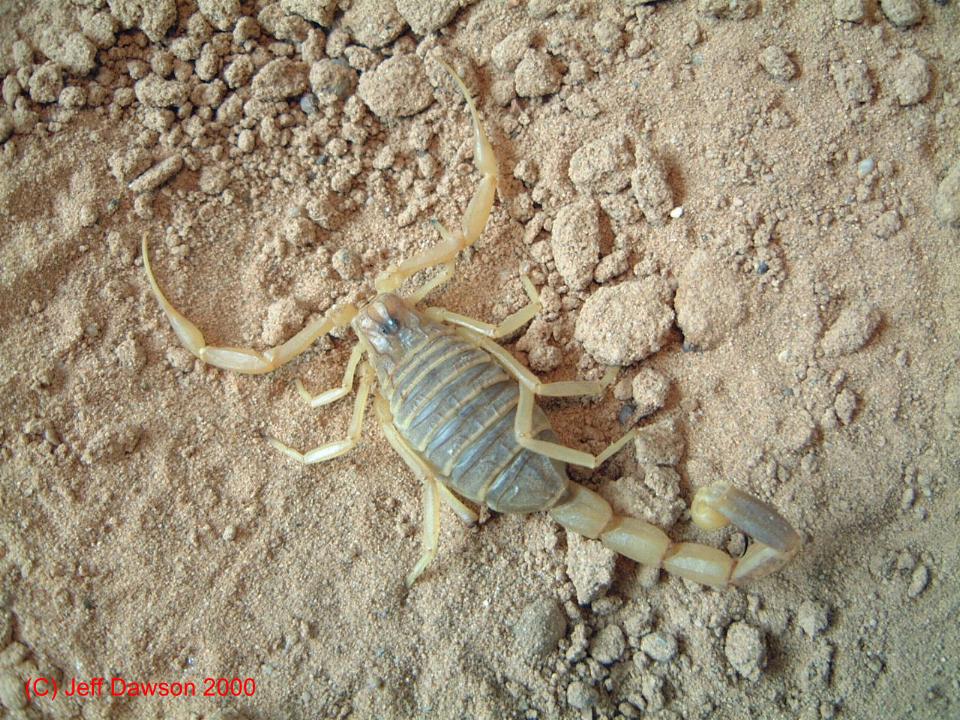|
Leiurus quinquestriatus
(Ehrenberg,
1928)
|
|

|
|
Common names:
This scorpion is usually known as the Death
Stalker.
Distribution:
Africa (Algeria, Chad, Egypt, Ethiopia, Libya, Mali,
Niger, Somalia, Sudan, Tunisia) and Asia (Egypt, Israel,
Jordan, Kuwait, lebanon, Oman, Quatar, Saudi Arabia,
Syria, Turkey, United Arab Emirates, Yemen).
Habitat:
This scorpion is found in dry habitats/desert areas on
different substrate types (but not in sand dunes). The
species hide in small natural burrows or under stones
etc.
Venom:
This is one of the worldst most dangerous
scorpion, with a very potent venom. This species are
medical important, and cause several deaths each year. LD
value of 0.16 - 0.50 mg/kg!
A study from Israel shows that only localized reactions occur in
97% of the victims, but the venom can be potentially letal in
children because the severity of the symptoms is weight-dependent.
Antivenin is available for this species, but should be used only for severe cases.
See Scorpion of Medical
Importance page for more information.
Selected litterature:
Ben-Abraham, R. et al. (2000). Triage for Leiurus quinquestriatus
scorpion envenomation in children - is routine ICU hospitalization necessary.
Hum. Exp. Toxicol., vol. 19 (12), pp. 636-666.
Gueron, M. et al.: Echocardiographic and
Radionuclide Angiographic Observatios following Scorpion
Envenomation by Leiurus quinquestriatus, Toxicon,
Vol. 28, No. 9, pp. 1005 ff., 1990.
Sofer, S. et al.: Myocardial Injury without Heart Failure
following Envenomation by the Scorpion Leiurus
quinquestriatus in Children, Toxicon, Vol. 29, No. 3,
pp. 382 ff., 1991.
Dudin, A.A., A. Rambaud-Cousson, A. Thalji, I. Juabeh & B. Abu-Libdeh.
Scorpion stings in children in the Jerusalem area: a review of 54 cases.
Ann. Trop. Paediatr., vol. 11, pp. 217-223. 1991.
El-Amin, E.O., A. Elidrissy, H. S. Hamid, O.M. Sultan & R.A. Safar.
Scorpion sting: a management problem.
Ann. Trop. Paediatr., vol. 11, pp. 143-148. 1991.
Sofer, S. et al.: Acute Pancreatitis in Children
following Envenomation by the Yellow Scorpion Leiurus
quinquestriatus, Toxicon, Vol. 29, No. 1, pp. 125
ff., 1991.
Ismail, M. et al.: Do changes in body temperature
following envenomation by the scorpion Leiurus
quinquestriatus influence the course of toxicitiy?,
Toxicon, Vol. 28, No. 11, pp 1265 ff. 1990.
Sofer, S., Gueron, M.: Respiratory failure in children
following envenomation by the scorpion Leiurus
quinquestriatus: hemodynamic and neurological
aspects, Toxicon, Vol. 26, No. 10, pp. 931 ff, 1988.
Gueron, M., Yaron, R.: Cardiovascular Manifestations of
severe scorpion sting, Chest, Vol. 57, No.2, February
1970.
Cloudsley-Thompson, J. L. (1961). Observations on the biology of the
scorpion Leiurus quinquestriatus in the Sudan. Ent. Month. Mag., vol. 97, pp. 153-155.
Abushama, F. T. (1968). Observations on the mating
behaviour and borth of Leiurus quinquestriatus (H.
& E.), a common scorpion species in the Central
Sudan. Rev. Zool. Bit. Afr., vol. 77, pp. 37-43.
Abushama, F. T. (1964). On the behaviour ans sensory physiology of the
scorpion Leirus quinquestriatus. Animal behaviour, vol. 12, pp. 140-153.
Dejours, P. and A. Ar (1991). Temperature and starvation affect the
hemolymph acid-base balance of the xeric yellow scorpion, Leiurus
quinquestriatus. J. Comp. Phsyiol. B, vol. 161, pp. 407-412.
El Bakary, Z. and Fuzeau-Braesch (1988). Circadian rythms and time
measurement in locomotor activity of the scorpion Leiurus quinquestriatus
(Buthidae). Chronobiology International, vol. 5(2), pp. 167-174.
Flatt, T. (1991). Beobachtungen zum paarungsverhalten von
Leiurus quinquestriatus (Scorpiones: Buthidae)
in gefangenschaft. Latrodecta, vol. ??, pp. 6-10.
Braendle, C. (1995). Verhalten und økologie des
skorpions Leiurus quinquestriatus. DATZ, vol.
48, pp. 782-783.
Benton, T.G.(1992)
Courtship and mating in Leiurus quinquestriatus (Scorpiones: Buthidae).
In: Proc. one day Symp. on Spiders and Their Allies held on saturday 21st
November 1987 at the Zoological Society of London (J.E. Cooper, P.
Pearce-Kelly & D.L. Williams, eds.). Pp. 83-98.
On the Internet:
Gifttier
Informationsdienst on L. quinquestriatus.
SCORPION
STING SYNDROME - A TEN YEAR EXPERIENCE (fulltext
article).
SCORPION
ENVENOMATION IN CHILDREN: SHOULD ALL STINGS BE GIVEN
ANTIVENOM? (fulltext article).
General:
This species grows up to 10 cm in length, and is usually
straw yellow to orangish yellow. This species is very
unique in that it has five keels on mesasomal tergites
l-ll. With the remaining tergites lll-Vll with the
typical three dorsal keels. Pedipalp wise, the tarsus and
tibia finger fit perfectly closed together. And the tibia
hand is scarcely wider than the closed fingers combined.
Metasomal segment V is dark in coloration (this can be
weak/absent in adult specimens).
This species is beeing kept in captivity. Under no
circumstances should this species be kept by other than
scientists or professional keepers. This is a very
dangerous species!
NB! This species is simmilar to other scorpion
species, and misidentifications from suppliers occur!
I'm not aware of any research on the biology of this
species, but research on and with Leiurus venom
is going on all the time.
Leiurus quinquestriatus photo
by Jeff Dawson (C)
Some of Leiurus quinquestriatus text
is written by Dave Cunningham
|